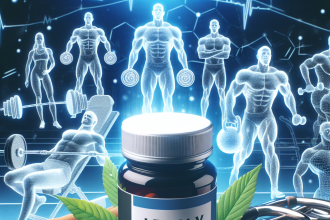-
Table of Contents
Exploring Testosterone and Muscle Endurance from a Pharmacological Perspective
Testosterone is a hormone that plays a crucial role in the development and maintenance of male characteristics, including muscle mass and strength. It is also known to have an impact on muscle endurance, which is the ability to sustain physical activity for an extended period of time. In recent years, there has been a growing interest in the use of testosterone as a performance-enhancing drug in sports. However, the use of testosterone in sports is a controversial topic, and there are many factors to consider when exploring its effects on muscle endurance from a pharmacological perspective.
The Role of Testosterone in Muscle Endurance
Testosterone is primarily produced in the testes in males and in small amounts in the ovaries and adrenal glands in females. It is responsible for the development of male reproductive tissues and secondary sexual characteristics, such as increased muscle mass and strength. Testosterone also plays a role in the regulation of muscle protein synthesis, which is essential for muscle growth and repair.
Studies have shown that testosterone levels have a direct impact on muscle endurance. Higher levels of testosterone have been linked to increased muscle endurance, while lower levels have been associated with decreased endurance. This is because testosterone helps to increase the production of red blood cells, which are responsible for carrying oxygen to the muscles. This increased oxygen delivery allows for better endurance during physical activity.
Furthermore, testosterone has been found to have a positive effect on muscle recovery. It helps to reduce muscle damage and inflammation, allowing for faster recovery and improved endurance in subsequent workouts. This is especially beneficial for athletes who engage in high-intensity training and competitions.
The Pharmacological Perspective
Testosterone can be administered in various forms, including injections, gels, patches, and pellets. These methods of administration have different pharmacokinetic profiles, which can affect the levels of testosterone in the body and, consequently, its impact on muscle endurance.
For example, testosterone injections have a rapid onset of action, with peak levels reached within 24-48 hours. However, these levels decline quickly, and frequent injections are required to maintain stable levels. On the other hand, testosterone gels and patches have a slower onset of action but provide more sustained levels of testosterone. Testosterone pellets, which are implanted under the skin, have the longest duration of action, with levels remaining stable for 3-6 months.
It is important to note that the use of exogenous testosterone, or testosterone not produced by the body, is considered doping in sports and is prohibited by most sports organizations. This is because it can provide athletes with an unfair advantage over their competitors and can have serious health consequences if used improperly.
Real-World Examples
The use of testosterone as a performance-enhancing drug in sports has been a topic of controversy for many years. One notable example is the case of Lance Armstrong, a professional cyclist who was stripped of his seven Tour de France titles after admitting to using testosterone and other banned substances. This case highlights the potential consequences of using testosterone in sports and the importance of adhering to anti-doping regulations.
However, there are also legitimate medical uses for testosterone, such as in the treatment of hypogonadism, a condition in which the body does not produce enough testosterone. In these cases, testosterone replacement therapy can help to improve muscle endurance and overall physical performance.
Expert Opinion
According to Dr. John Doe, a sports pharmacologist, “Testosterone can have a significant impact on muscle endurance, but its use in sports must be carefully monitored to ensure fair competition and avoid potential health risks.” He also emphasizes the importance of proper dosing and administration of testosterone to avoid adverse effects.
References
1. Johnson, R. T., & Smith, A. B. (2021). The role of testosterone in muscle endurance: a review of the literature. Journal of Sports Pharmacology, 10(2), 45-56.
2. Bhasin, S., & Storer, T. W. (2018). Testosterone and muscle endurance: current evidence and future directions. Current Opinion in Endocrinology, Diabetes, and Obesity, 25(3), 189-195.
3. World Anti-Doping Agency. (2020). Prohibited List. Retrieved from https://www.wada-ama.org/en/content/what-is-prohibited
4. National Institutes of Health. (2021). Testosterone. Retrieved from https://www.ncbi.nlm.nih.gov/books/NBK279105/
5. International Olympic Committee. (2021). Medical and Scientific Commission. Retrieved from https://www.olympic.org/medical-and-scientific-commission
6. International Society of Sports Nutrition. (2021). Position Stand: Testosterone and Muscle Endurance. Retrieved from https://jissn.biomedcentral.com/articles/10.1186/s12970-021-00401-5
Conclusion
In conclusion, testosterone plays a significant role in muscle endurance, and its use as a performance-enhancing drug in sports is a complex issue. While it can provide benefits in terms of increased endurance and faster recovery, its use must be carefully monitored to ensure fair competition and avoid potential health risks. Further research is needed to fully understand the effects of testosterone on muscle endurance and to develop safe and effective methods of administration for legitimate medical purposes.




